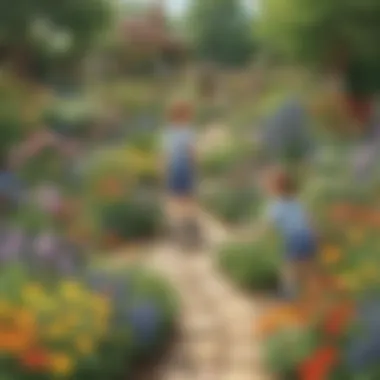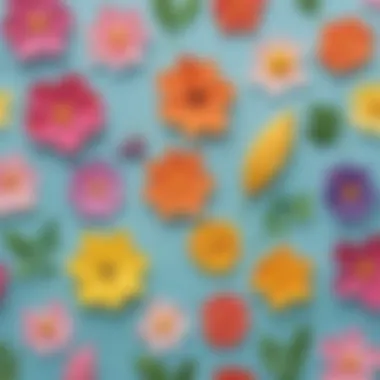Engaging Flower Activities for Preschool Learners


Intro
In this guide, we will examine the fascinating world of flowers and how they can seamlessly fit into preschool activities. Engaging young minds with nature not only boosts their appreciation for the environment but is also a key factor in their cognitive and social development. This discussion covers a range of ideas and experiments that are accessible and enjoyable for both educators and parents.
Science Fun Facts
Interesting Trivia and Facts
Flowers are not just beautiful; they serve many purposes in nature. Did you know that the largest flower in the world is the Rafflesia arnoldii? It can reach up to three feet in diameter and smells like rotting meat to attract its pollinators.
Quirky Science Stories
There are stories in the plant kingdom that are simply astounding. One famous tale involves Charles Darwin and his fascination with orchids. He studied how these flowers evolved unique shapes and scents to attract specific pollinators, showcasing the intricate relationships in nature.
Amazing Science Records
Some flowers have remarkable features. For instance, the Corpse Flower blooms rarely and can grow to be one of the tallest flowers in the world, reaching heights of up to ten feet! Its name comes from the foul smell that mimics decomposing flesh, attracting certain insects for pollination.
Thought-Provoking Questions
Encourage curiosity with questions like:
- How do flowers attract bees?
- What role do flowers play in our ecosystem?
- Why do different flowers have different colors?
Discover the Wonders of Science
Exploring Various Scientific Concepts
Understanding flowers can introduce children to concepts like photosynthesis, plant biology, and ecosystems. Simple explanations can help them grasp how flowers grow and reproduce.
Educational Videos and Animations
Utilizing resources such as educational videos from platforms like Britannica can spark interest. These videos provide visuals that enhance understanding of complex ideas in a fun way.
Interactive Learning Tools
Tools like flower identification apps or interactive gardening websites can be beneficial. They allow children to learn by doing, enhancing their engagement with the subject.
Real-Life Applications of Science
Discuss how flowers contribute to food production, like fruits and vegetables, showing a direct connection to what they eat. Understanding botany helps nurture environmental stewardship from a young age.
Science Quiz Time
Interactive Quizzes
Creating fun quizzes about flowers can make learning enjoyable. For example, ask children to match flowers with their colors or shapes.
Multiple Choice Questions
- What does photosynthesis help flowers do?
- A) Grow taller
- B) Make food
- C) Change colors
Answer: B) Make food
Brain Teasers and Puzzles
Engage kids with simple puzzles about flower species or their parts. This could be a jigsaw puzzle of a flower, helping them learn while playing.
Learning Through Gamification
Use games that incorporate flower-related themes. Gardening games, for example, can teach responsibility as children care for virtual plants.
Science Experiment Showcase
Fun and Engaging Experiments
There are many simple experiments that can be done with flowers. One such activity is the colored water experiment, where children place white flowers in colored water and observe how they absorb the dye.
Step-by-Step Instructions
- Gather materials: white flowers, clear glasses, colored dyes, and water.
- Fill glasses with water and add dye.
- Place flowers in the dyed water.
- Wait a few hours, then observe changes.
Materials List
- White flowers (like daisies or carnations)
- Clear glasses
- Food coloring or water-based dyes
- Water
Safety Tips and Precautions
Ensure children do not consume any materials used in experiments. Supervision is key when handling water and dyes.
Incorporating flower activities into preschool education not only makes learning fun but also paves the way for a deeper understanding of nature.
By recognizing the different aspects of flowers, children can learn not only science but also develop their curiosity about the world around them. This exploration can create lasting impressions and knowledge that contribute to their education.
Prelude to Flower Activities in Preschool


Flower activities in preschool offer a rich tapestry of learning opportunities designed to cultivate curiosity in children. Engaging with flowers can provide numerous benefits to young learners, laying a foundation for understanding the natural world. This introduction outlines the significance of these activities while highlighting various aspects that enhance early education.
An essential element of flower activities is exposure to the environment. Children learn about different types of flowers, their colors, shapes, and sizes. This exposure fosters their observational skills and enhances their appreciation for biodiversity. Activities centered around flowers can also improve motor skills, allowing children to practice actions such as planting, watering, and arranging.
Through flower activities, emotional skills may develop, as children learn to care for living things. These experiences introduce themes of responsibility and nurturing, which are crucial for their social and emotional growth. The activities promote teamwork, giving students opportunities to collaborate, share, and connect with peers.
Furthermore, integrating flower-centered lessons into the curriculum aligns with educational goals aimed at holistic child development. Early exposure to botanical concepts can spark a lifelong interest in science and nature.
Importance of Floral Exposure in Early Education
Floral exposure serves multiple functions in early education. Children are naturally drawn to vibrant colors and unique shapes, which make flowers an excellent tool for learning. When children engage with flowers, they are not only absorbing aesthetic elements but are also learning basic biology.
Research shows that connecting children with nature promotes cognitive growth. For instance, identifying different species of flowers reinforces recognition skills and memory. Children often develop an innate curiosity, prompting them to ask questions and seek answers about plants and their habitats. These questions foster critical thinking and enhance problem-solving skills.
"Engagement with nature can increase focus and decrease stress levels in children, contributing positively to their overall wellbeing."
Additionally, floral exposure in preschool encourages sensory exploration. The varying textures, scents, and colors offer opportunities for children to refine their senses while linking these experiences to scientific concepts regarding plant life. Sensory education supports young learners in making connections to their surroundings.
Objectives of Flower Activities
The primary objectives of integrating flower activities into preschool education include fostering curiosity, teamwork, and environmental awareness. Children develop a foundational understanding of botany as they learn about the life cycle of plants and the roles of various species in ecosystems.
- Fostering Curiosity: Engaging with flowers stimulates children's natural curiosity, prompting them to investigate the world around them.
- Promoting Teamwork: Many flower activities involve group work, enhancing communication skills and building relationships among peers.
- Enhancing Sensory Skills: Through tactile interaction and observation, children refine their senses, improving overall cognitive development.
- Encouraging Responsibility: Activities that involve caring for flowers teach children the value of responsibility and empathetic behavior.
- Instilling Environmental Awareness: Understanding the significance of flowers within ecosystems helps develop a sense of responsibility toward nature and encourages preservation.
In summary, exploring flower activities in preschool serves several critical educational objectives. It enhances cognitive, social, and emotional development while instilling a sense of respect for the environment. These early interactions with flowers lay the groundwork for deeper scientific understanding and appreciation for the natural world.
Types of Flower Activities
Flower activities play a crucial role in preschool education. They not only engage children but also help them develop important skills. Through various activities centered on flowers, young learners can enhance their cognitive abilities, motor skills, and social interactions.
In this section, we will explore two main categories: outdoor activities and indoor activities. Each of these categories serves distinct purposes and offers unique benefits for preschool children. Outdoor activities connect children to nature, while indoor activities stimulate creativity and fine motor skills. Both forms of engagement help children appreciate flowers and their role in the ecosystem.
Outdoor Activities
Flower Identification Walks
This activity focuses on teaching children how to identify different flowers in their environment. A flower identification walk allows children to explore nature, observing various species. This experience enhances their observational skills and encourages curiosity.
A key characteristic of flower identification walks is the hands-on experience children receive. They interact directly with their surroundings, which deepens their understanding of flora. Since preschoolers are naturally curious, this activity is a beneficial choice for this article. They learn the importance of flowers in nature while having fun.
The unique feature of this activity is its ability to blend learning with exploration. Children can gather samples, identify colors, and discuss shapes, making it an enriching experience. The only downside might be the need for supervision to ensure safety when exploring outdoors.
Planting Flowers
Planting flowers offers children a chance to engage directly with gardening. This activity teaches them how to care for living things. It also provides a practical lesson in responsibility, as they see the results of their efforts over time.
The key characteristic of planting flowers is its hands-on nature. Children physically plant seeds or bulbs, water them, and watch them grow. It fosters a sense of accomplishment and connection to nature. This makes it a popular choice in this article.
One unique aspect of planting flowers is the long-term commitment it fosters. Children can observe the growth process, making connections between their actions and results. However, the drawback could be that some plants require special conditions to thrive, which may limit what can be planted in certain environments.
Gardening Basics
Teaching preschoolers gardening basics combines educational content with physical involvement. Children learn essential gardening skills and gain appreciation for the natural world.
The core feature of gardening basics is that it provides comprehensive exposure to plant care. Children learn to plant, water, and tend to flowers. Such activities encourage not just facts about gardening but also practical skills. This makes it a beneficial choice for this article.
A unique part of gardening basics is the variety of skills learned, from using tools to understanding soil health. However, some children might find gardening tedious if they do not see immediate results. This requires patience and guidance from adults to encourage ongoing interest.
Indoor Activities
Flower Craft Projects
Flower craft projects enable children to express their creativity while working with different materials. These activities encourage fine motor skills and artistic expression.
A vital aspect of flower craft projects is the use of various materials to create floral-themed items. This includes paper, paint, and recycled materials. Such activities engage children's imagination, making it a beneficial choice for this article.
The unique feature of flower craft projects is their flexibility. Children can create whatever they envision, which fosters individuality. The downside may be the potential mess involved, requiring adequate preparation for cleanup.
Petal Sorting Game
This activity emphasizes organization and categorization skills. In the petal sorting game, children can sort petals by color, size, or type, increasing their cognitive skills.
A defining characteristic of the petal sorting game is its interactive nature. Children engage with real petals, enhancing their tactile experience. This makes it a beneficial choice for this article as it ties learning to real-life sensory engagement.
The unique aspect of this game is its adaptability. It can be modified for different skill levels, making it accessible. However, a downside is that it may require supervision to prevent any mishaps with sharp or irritating petals.
Flower-Themed Story Time
Flower-themed story time engages children's listening and comprehension skills. Reading stories about flowers can spark curiosity and introduce new vocabulary.
Its essential characteristic is the narrative context it provides. Stories can foster emotional connections to nature and inspire learning. This makes it a beneficial choice in this article.
The unique feature of this activity is its ability to combine learning with relaxation. Story time can be calming and can serve as a transition between more active activities. A potential drawback might be that children may lose interest if the stories are too lengthy or not interactive.
Integrating Art and Flowers
Integrating art and flowers presents a rich avenue for preschool activities, blending creativity with nature. This intersection is essential as it encourages children to express themselves while developing an appreciation for the natural world. Understanding flowers through art allows for hands-on learning experiences. Children engage their senses, stimulating both their cognitive and emotional growth. This approach also cultivates fine motor skills through various artistic techniques, enhancing dexterity and coordination.
Painting with Flowers


Painting with flowers is an innovative activity that merges sensory experiences with artistic expression. In this activity, preschoolers can use actual flower petals or leaves to create texture and color in their paintings.
Here’s how it can work:
- Gather Materials: Collect various flowers, non-toxic paint, and paper. Choosing vibrant colored flowers adds visual interest.
- Explore Petals: Allow children to explore the shapes and colors of the flowers. Discussing the variety of flowers can also introduce basic botanical concepts.
- Create Art: Dip the petals in paint and press them onto the paper. This method helps children to replicate the shapes of flowers and understand how each petal contributes to the overall design.
- Clean Up: Engage children in cleaning the work area, promoting responsibility and teamwork.
Painting with flowers not only fosters creativity but also enhances sensory observation and fine motor skills. It is essential for educators and parents to support children in articulating their thoughts and feelings about their artwork, further enriching the educational experience.
Creating Flower Collages
Creating collages using flowers allows preschoolers to explore their creativity while learning about composition and arrangement. Collages help improve visual-motor coordination and promote imaginative thinking. Here are some steps to incorporate this activity:
- Collect Natural Materials: Encourage children to gather a variety of flowers, leaves, and twigs. This exploration enhances their understanding of local flora.
- Choose a Base: Provide sturdy paper or cardboard as a base. Children can think about how they wish to arrange their flowers before glue is applied.
- Arrange and Glue: Instruct children to arrange their collected items on the base without gluing first. This allows them to consider design and placement critically. Once satisfied, they can begin gluing.
- Discuss the Project: As children create, have conversations about the colors, shapes, and textures they are using. This not only develops their vocabulary but also reinforces their understanding of art principles.
The collage-making process is beneficial for cognitive development, enhancing skills like categorization and pattern recognition. The end result is not only a beautiful piece of art but also a personal reflection of experiences with nature.
Scientific Exploration through Flowers
Scientific exploration through flowers offers preschool-aged children a foundational understanding of biology and ecology. This segment plays a crucial role in fostering critical thinking and curiosity about the natural environment. Engaging with flowers allows young learners to experience firsthand the complex processes of life, growth, and reproduction in plants. Such activities not only promote cognitive development but also nurture an appreciation for the intricate relationships that exist within ecosystems.
The Life Cycle of Plants
The life cycle of plants is a fundamental concept in understanding how flowers grow and reproduce. It involves several stages: germination, growth, flowering, pollination, and seed dispersal. Introducing preschoolers to these stages can be done with hands-on activities. For example, planting seeds in small pots allows children to witness each phase as they care for their plants.
To enhance comprehension, educators can use visuals such as illustrated posters or simple diagrams. Storybooks that focus on plant life cycles can also be effective resources. These methods will not only make learning enjoyable but reinforce the sequence of events in a plant’s life.
Pollination and Its Importance
Pollination is a key process in the reproduction of flowering plants. It involves transferring pollen from the male parts of a flower to the female parts. This leads to fertilization and, ultimately, the production of seeds. Educating preschoolers about pollinators, such as bees and butterflies, is essential.
Activities can include observing these creatures in a garden or using craft projects to create models of flowers and pollinators. Discussing the significance of pollination helps children understand the role it plays in food production and the health of ecosystems. Educational games that simulate pollination processes can also contribute to their engagement and understanding.
Key Insights:
- The scientific exploration of flowers provides essential knowledge about ecological systems.
- Learning about the life cycle and pollination fosters curiosity and environmental awareness.
Through these scientific explorations, preschoolers are equipped with knowledge about the natural world, enhancing their cognitive development while instilling a love for nature that can last a lifetime.
Cognitive Development Activities
Cognitive development is a crucial aspect of early childhood education. Engaging preschoolers in activities that center around flowers can significantly enhance their cognitive skills. These activities help in improving memory, problem-solving, and critical thinking. Furthermore, hands-on learning enables children to connect concepts with real-life experiences, promoting a deeper understanding of their environment.
Frameworks in early education emphasize the role of play in learning. Flower activities provide a natural platform for children to explore and experiment. This exploration contributes to mental development by sharpening their observation skills, developing vocabulary, and enhancing attention spans. The ideas we present here can be simple yet profound, offering educators and parents practical ways to make learning interconnected and engaging for preschoolers.
Flower Memory Games
Flower memory games are an excellent way to build memory skills in young learners. These games can be designed using illustrations of various flowers. Children can be encouraged to match pairs of the same flower. This can also be conducted as a group activity, fostering a spirit of cooperation and competition among peers. As children play, they not only improve their memory but also engage in conversation about the flowers featured, which expands their vocabulary and encourages social interaction.
Benefits of Flower Memory Games:
- Reinforces memory retention through repetition
- Encourages teamwork among students
- Provides a fun way to learn about biodiversity
Pattern Recognition with Flower Shapes
Pattern recognition is vital for developing logical reasoning skills. Activities centered around flower shapes give children practical opportunities to identify, predict, and continue patterns. For instance, children can create sequences using cut-out shapes of different flowers. Additionally, this could be expanded into identifying patterns in nature, such as observing flower arrangements in a garden. This type of activity enhances not only cognitive skills but also nurtures creativity.
Considerations for Implementing Pattern Recognition Activities:
- Use various flower shapes to introduce complexity
- Integrate color recognition as an added layer
- Promote group discussions about patterns found in nature
Engaging preschoolers in activities connecting flowers and cognition supports a holistic approach to their development.
These cognitive development activities pave the way for deeper learning experiences, as each interaction with flowers will not only be educational but also truly memorable.
Sustainability and Environmental Awareness
Sustainability and environmental awareness play a crucial role in preschool flower activities. These concepts are important as they help children develop a connection with nature. Understanding the environment helps young learners recognize their impact on the world. Through engaging with flowers, children learn about ecosystems, biodiversity, and the delicate balance of nature. This sets a foundation for responsible behavior as they grow.
One element of sustainability that can be highlighted through these activities is the proper care of plants. When children participate in planting and nurturing flowers, they understand the requirements of growth, such as water, sunlight, and soil health. These lessons encourage respect for nature and teach children about renewable resources.
Benefits of including sustainability in flower activities include:
- Development of empathy: Children learn to care not only for flowers but for all living things.
- Encouragement of inquiry: Engaging with local flora inspires questions about the environment.
- Establishment of habits: Understanding sustainable practices helps children form habits that benefit the earth.
Incorporating sustainability into preschool activities encourages curiosity about how they can make a difference.
Understanding Local Flora
Understanding local flora is essential when teaching preschoolers about flowers. Children gain valuable insights into the plants they encounter in their daily lives. Familiarity with local species enables young learners to connect with their environment meaningfully. When children can identify plants in their surroundings, their appreciation for nature deepens.
Teachers and caregivers can introduce activities that involve exploring local gardens or parks. During these outings, they can encourage children to observe different flower species. Simple identification games can enhance their recognition skills. Additionally, discussing the characteristics of local flowers fosters an understanding of the diversity found in nature.
Importance of Pollinators
Pollinators are vital to flower growth and health. Educating preschoolers about their role in the ecosystem is fundamental. Bees, butterflies, and other insects play a crucial part in the process of pollination. Through these activities, children understand that these small creatures significantly contribute to their environment.
Engaging flower activities can be designed to highlight pollinators. For instance, children can create a small pollinator garden. This allows them to witness pollinators in action and understand their importance. They can also learn through stories and illustrations how flowers and pollinators depend on each other.
Encouraging young minds to care about pollinators will help develop a sense of environmental stewardship.


"Teaching children about sustainability and the role of pollinators will help foster an early appreciation for nature and its intricate connections."
In summary, including sustainability and environmental awareness in preschool flower activities benefits both children and the environment. Through various engaging methods, future generations can be better equipped to care for their surroundings.
Social Interaction through Flower Activities
Engaging preschoolers in flower activities offers a unique opportunity to foster social interaction among young learners. Social skills are crucial at this age, as children learn to communicate, collaborate, and build relationships. Utilizing flower activities can help create an inclusive environment where children feel comfortable to express themselves.
Through these activities, children can learn to share responsibilities and appreciate diverse perspectives. When children work together, it encourages teamwork and problem-solving. They learn to listen to each other and contribute their ideas in meaningful ways. Group activities linked to flowers often lead to discussions about colors, shapes, and the natural world. This not only stimulates their cognitive development but also enhances their emotional connections.
Moreover, the joyful nature of flower-related tasks can break down social barriers. Children who might be shy or hesitant in other settings may find common ground when handling flowers, planting, or creating artworks together. Such experiences help them to practice empathy and friendly interactions without the pressure of strict social norms.
Group Planting Sessions
Group planting sessions are an excellent way to cultivate social skills among preschoolers. Involving multiple children in the process of planting flowers can facilitate communication and teamwork. Each participant can take turns digging, placing seeds, and watering, allowing for hands-on learning while fostering collaborative play.
During these sessions, educators can guide discussions about the needs of plants—such as sunlight, water, and soil—creating opportunities for questions and answers. Children can share their thoughts about favorite flowers or experiences with gardening, enhancing their listening and communication skills. Such interactions can also lead to the discovery of individual preferences, promoting diversity in opinion and thought.
To organize effective group planting sessions, consider these steps:
- Divide the class into small groups to manage participation better.
- Provide each group with different types of seeds to enhance variety.
- Create a schedule for maintenance, encouraging a sense of responsibility.
"Working together not only helps plants grow but also nurtures friendships among children."
Collaborative Art Projects
Collaborative art projects are another effective way to enhance social interaction among preschoolers. Working as a group to create flower-themed art can be both exciting and educational. Children can use various materials like petals, painted leaves, or recycled items to create visually appealing pieces. This collaborative effort combines creativity with group dynamics.
As children brainstorm and discuss their project, they practice expressing ideas and respecting the input of others. It sets a platform for negotiation—deciding on colors, shapes, and designs—allowing them to engage in critical thinking. Furthermore, these art projects can be displayed in the classroom or sent home, fostering a sense of achievement and pride in their collective work.
To successfully implement collaborative art projects, consider these tips:
- Set clear and achievable goals for the project.
- Provide guidelines for collaboration, encouraging equal participation.
- Allow for individual expression within the group framework, respecting personal styles.
Safety Considerations in Flower Activities
Engaging preschoolers in flower activities is not only fun but also educational. However, implementing these activities requires careful consideration regarding safety. Ensuring a safe environment helps protect young children while they explore the world of flowers. The importance of safety cannot be overstated when working with plants, as this impacts not only physical well-being but also the overall experience of learning about nature.
The benefits of recognizing safety considerations include reducing the risk of injuries and allergic reactions. When educators and parents make safe choices, children can fully engage in exploration and learning without unnecessary worry.
Identifying Non-Toxic Plants
A crucial aspect of safety in flower activities is identifying non-toxic plants. Some flowers, while beautiful, can be harmful if ingested or touched. Educators should create a list of safe plants suitable for preschoolers. Examples include marigolds, pansies, and zinnias. It is advisable to familiarize oneself with local flora to ensure all plants in the vicinity are safe for children.
Additionally, educators can involve children in discussions about non-toxic plants. This educates them about nature while providing essential safety knowledge. Teaching children to recognize non-toxic plants fosters a sense of responsibility and caution.
Allergy Awareness
Another vital safety consideration is allergy awareness. Some children might have allergies to specific flowers or plants. Common allergens include pollen from sunflowers and daisies. It is important for educators and caregivers to be aware of children’s allergies before organizing any flower activities.
Parents should be encouraged to communicate with educators concerning any allergy history. This allows for the safe selection of flowers during activities.
If a flower activity involves various species, it is useful to provide an allergen-free option for those affected. Incorporating this flexibility ensures that every child can participate without risking discomfort or health issues.
Awareness of allergies is crucial. Always check with parents and have alternatives ready.
Integrating safety measures into flower activities enriches the learning experience. With suitable preparation and awareness, young children can explore flowers safely and joyfully. This approach not only safeguards health but also supports the continued excitement for learning about nature.
Assessment and Evaluation of Flower Activities
Evaluating flower activities in preschool is essential for understanding their effectiveness in promoting learning among young children. Assessment helps educators and caregivers to determine if the activities meet educational objectives. Furthermore, it guides in refining the methods and approaches for future sessions, ensuring that each interaction with flowers becomes a valuable learning experience. Assessing these activities can shed light on various elements such as engagement levels, skill development, and emotional connection with nature.
Observational Assessments
Observational assessments are a key component of evaluating flower activities. This method involves watching the children as they engage in various tasks related to flowers. Educators should take note of how children interact with different aspects such as plant care, identification, and artistic expression. Some factors to observe include:
- Initiative: Are children taking the lead in planting, watering, or creating crafts?
- Collaboration: Do they work well with peers? Are they sharing tools and ideas?
- Curiosity: Are children asking questions about the flowers and their features?
- Skill Development: Can they identify flowers or demonstrate careful handling of plants?
These observations help in assessing cognitive and social growth. They provide insight into whether or not the children are meeting developmental milestones linked to science education and environmental awareness.
Feedback and Reflection
Feedback and reflection play a vital role in the evaluation process. After engaging in flower activities, it's important to provide children with structured opportunities to express their thoughts. This can be done through group discussions or individual reflection sessions. Some effective methods for gathering feedback include:
- Journals: Encourage children to draw or write about their experiences with flowers. This activity stimulates critical thinking and allows them to articulate their feelings.
- Group discussions: Create a safe space for children to share what they liked, learned, or found challenging about the activities.
- Parental feedback: Involve parents by asking them to share observations on how their children discussed or acted on their experiences at home.
Reflecting on both feedback from children and insights from parents can help in refining future activities. This iterative process of assessment will help educators build a more robust curriculum that fosters a deep-rooted appreciation for nature among preschoolers.
End and Future Directions
In the realm of preschool education, flower activities offer a multifaceted approach to engage young minds. The conclusion serves to encapsulate the significant insights gained throughout this guide. Emphasizing the critical role flowers play in fostering children's curiosity, these activities blend education with nature. With practical applications explored, it becomes clear that the importance of integrating floral education extends beyond mere aesthetic appreciation.
Summarizing Key Insights
Throughout this journey into flower activities, several key insights emerge:
- Cognitive Development: Children enhance their cognitive skills through engaging activities like memory games and pattern recognition exercises.
- Social Interaction: Group activities promote collaboration and communication among preschoolers, nurturing essential social skills.
- Environmental Awareness: Understanding local flora and the importance of pollinators cultivates an early appreciation for ecological systems.
- Creativity Boost: Artistic projects such as flower collages and painting with flowers stimulate children's creativity, allowing them to express themselves uniquely.
These elements underscore the holistic impact of flower activities on preschool education, reminding educators and parents of the value they bring to child development.
Encouraging Ongoing Engagement with Nature
To further enhance children’s connection with the natural world, it is essential to create opportunities for ongoing engagement.
- Regular Outdoor Activities: Scheduled flower identification walks or gardening days can help maintain excitement and curiosity about the environment.
- Integration into Daily Routines: Incorporating flower themes into everyday activities, such as sharing stories about flowers during circle time, creates continuity in learning.
- Community Involvement: Families can involve their children in community gardening or local flora events, facilitating a sense of belonging and shared responsibility for nature.
- Resource Sharing: Parents can encourage exploration at home by providing access to books, websites like Wikipedia, and apps that focus on botany.
"Nurturing a child's fascination with flowers can lay a foundation for lifelong respect and love for nature."
Encouraging this sustained interaction with nature will reinforce the knowledge and skills developed during specific flower activities. Empowering young learners to remain engaged with their surroundings not only benefits their growth now but also fosters a future generation that values and protects the natural world.







